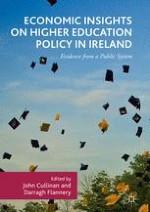2017 | OriginalPaper | Chapter
10. Student Financing of Higher Education
Authors : Darragh Flannery, Aedín Doris, Bruce Chapman
Published in: Economic Insights on Higher Education Policy in Ireland
Publisher: Springer International Publishing
Activate our intelligent search to find suitable subject content or patents.
Select sections of text to find matching patents with Artificial Intelligence. powered by
Select sections of text to find additional relevant content using AI-assisted search. powered by
